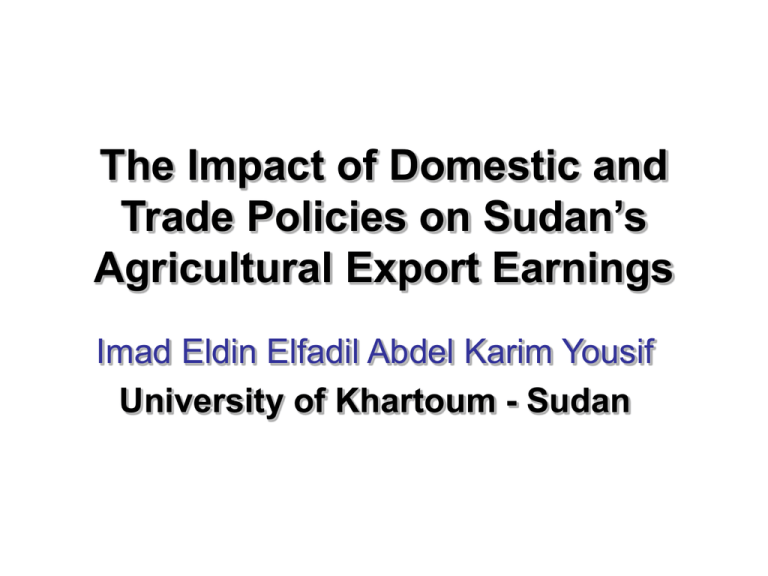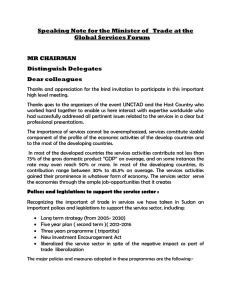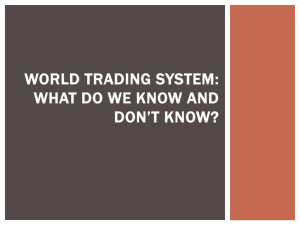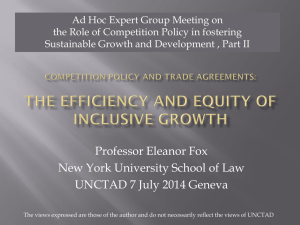The Impact of Domestic and Trade Policies on Sudan’s Agricultural Export Earnings
advertisement

The Impact of Domestic and Trade Policies on Sudan’s Agricultural Export Earnings Imad Eldin Elfadil Abdel Karim Yousif University of Khartoum - Sudan Contents • • • • • Introduction Multi-market model Scenarios Some selected results Conclusion Introduction • Agriculture in Sudan is important economy sector • Contributed about 45% of GDP • Major source of labor force • Food production • Till 1998 agricultural exports represent about 90% of total country export • This share declined to 12% in 2005 after oil exploitation • Agricultural sector in Sudan was subjected to various forms of taxation • The direct and indirect taxation of agricultural sector was the traditional source of government revenues • Sudan also relied on taxes imposed on international trade as a source of income • The results - Agricultural sector experienced continuous deterioration • In response - Sudan adopted liberalization and privatization policies as a means of development • Exports taxes and direct taxation on agriculture was a polished • However, many taxes are still imposed on agricultural production and export in different kind e.g. administration fees, transportation fees, production fees and other domestic taxes (zakat, state support fees, ports fees, profits tax and others). • Macroeconomic policy led to appreciation of Sudanese currency (appreciated by 21% by the end of 2006) • Increasing of foreign reserved due to oil exports • The indirect impact - many agricultural exports are uncompetitive in the world market • In this paper, a trial to estimate and quantify the effect of domestic taxation and appreciation of Sudanese currency on agricultural trade performance was carried out using a multi-market approach. Multi-Market Model • Comparative static, multi-commodities model • Built in excel Microsoft program • The model consists of a set of demand and supply equations for each commodity with the level of production and demand determined by factors such as prices, income, shift variables and various other assumptions about policies • The main policy instruments in the model are producer and consumer prices • The model allows for the simultaneous determination of supply, demand, trade levels and prices including their crossmarket linkages for all commodities covered. • The supply and demand functions in the model are specified as follows: q S i S Ci ( p ) i ii ( p )ij S j j i q K ( p ) ( p ) Y d i C i i C ii J i i ij i i • The price relationship in the model – assuming full transmission: S p i C p i w p i (1 t i ) x P w p i (1 t i ) C • Total welfare in the model is the sum of producer surplus, consumer surplus and government revenues • The model was calibrated to the base period data (average of 2000 and 2001) Scenarios • Partial liberalization scenarios - 50% reduction of taxes under base period foreign exchange rate (257 SD/US$). - 50% reduction of taxes under speculated foreign exchange rate (189 SD/US$) • Full liberalization scenarios - Full liberalization under base period foreign exchange rate - Full liberalization under speculated foreign exchange rate Some Selected Results Effects on domestic prices Percentage changes in the domestic prices under the simulated scenarios Full liberalization Partial liberalization Cotton Sesame Groundnut Sorghum Sugar Without appreciation of SD With appreciation of SD Without appreciation of SD With appreciation of SD 8.8 36.0 49.3 10.2 -16.3 -24.1 -5.1 4.2 -23.1 -41.6 17.6 72.1 98.7 20.5 -32.6 -17.9 20.1 38.7 -15.9 -53.0 Percentage changes in the domestic prices under partial Percentage change liberalization scenario 60 50 40 30 20 10 0 -10 -20 -30 -40 -50 cotton sesame groundnut Partial lib. without SD apprec. sorghum Partial lib. with SD apprec. sugar Trade Effects Absolute changes in the trade balance under the simulated scenarios (000 metric tons) Full liberalization Partial liberalization Cotton Sesame Groundnut Sorghum Sugar Without appreciation of SD With appreciation of SD Without appreciation of SD With appreciation of SD 8.1 21.4 2.6 26.7 -45.4 -62.2 2.1 28.4 -138.3 -70.5 18.3 38.1 1.3 65.9 -102.5 -53.3 18.3 33.1 -276.2 -201.5 Absolute changes in the trade balance under partial liberalization scenario 40 20 Thousand metric tons 0 -20 cotton sesame groundnut sorghum sugar -40 -60 -80 -100 -120 -140 -160 Partial lib. without SD apprec. Partial lib. With SD apprec. Welfare effects Absolute changes in producer surplus under partial liberalization scenario 40 30 Million SD 20 10 0 -10 cotton sesame groundnut sorghum -20 -30 -40 Partial lib. without SD apprec. Partial lib. With SD apprec. sugar Conclusion • The agricultural sector has been relatively ignored and neglected after oil exploitation • Liberalization policies could have positive impact on agricultural sector and its export earnings • The appreciation of Sudanese dinar has negative impact on the trade performance of agricultural exports • Liberalization policy alone is not enough to the development of the agricultural sector unless it has been combined with suitable macroeconomic policies


